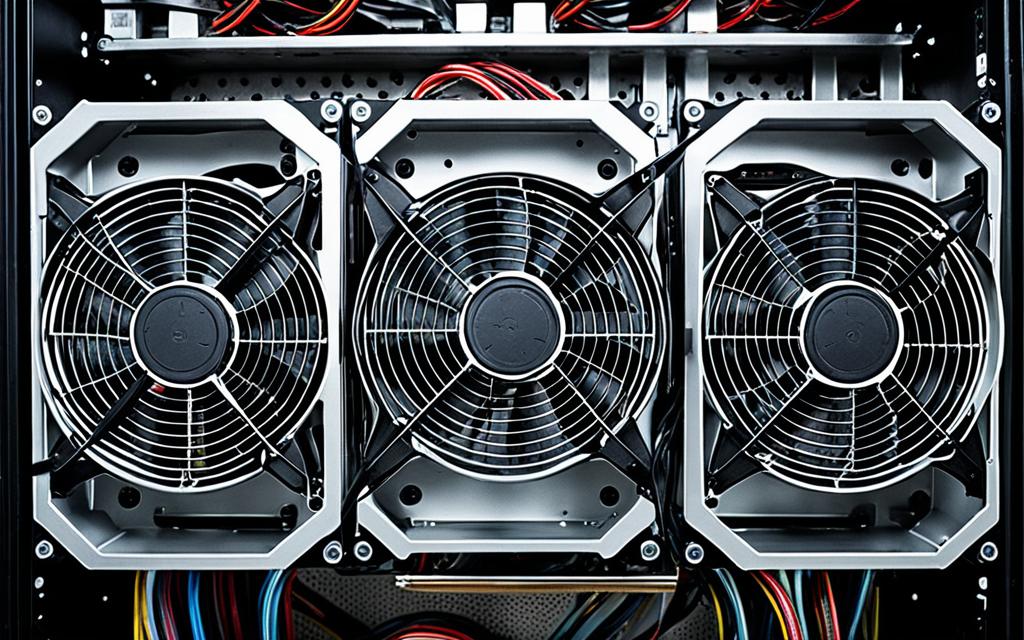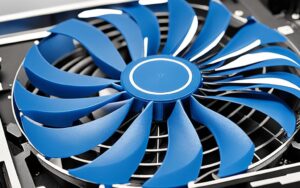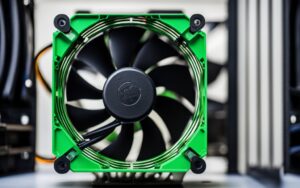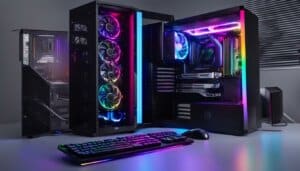Table of Contents
Getting the fan setup right is key to keeping your PC cool. Fans can blow in or out. Finding the best direction matters. Most PCs pull air in from the front and push it out the back. This setup considers where the PSU sits and avoids pushing hot air at the user. Fans on the back and the PSU usually work as outtakes. Intake fans are often at the front. Outtake fans help with airflow and keep the PC from getting too dusty1.
Key Takeaways:
- Proper fan configuration is essential for optimal cooling efficiency in PCs.
- Most cases have a front-to-back airflow, with air entering at the front and exiting at the back.
- Outtake fans are commonly placed at the back and on the PSU, while intake fans are sometimes positioned at the front.
- Outtake fans are preferred for better airflow and reducing dust accumulation concerns.
The Importance of Airflow in Cooling
In PC cooling, airflow is key for keeping things cool and making your system run well. Making sure hot air moves out quickly helps vital parts like the CPU and GPU last longer. It’s vital to know how airflow works and to use fans right to keep your PC cool2.
Place intake fans at the front and exhaust fans at the back for a good air flow. This setup pulls in cool air and pushes out hot air, stopping heat from building up2. Keep a balance with two exhaust fans for every intake fan to remove hot air faster2.
It’s important to have lower air pressure inside your PC case to cool it better. Exhaust fans pull hot air out, keeping temperatures safe. This also means less dust builds up inside. However, this setup might bring in more dust, so clean your PC regularly2.
How you position your fans matters a lot. Fans should blow in cool air from the front and bottom and out from the top and back. This helps keep important parts like your CPU and GPU cool. It avoids overheating and damage to your hardware2.
Proper airflow stops too much dust from gathering inside. Having more intake than exhaust fans can help with this. Yet, setups that cool better can draw in more dust. Choose what’s best for your cooling needs and how you’ll manage dust2.
In summary, good airflow is essential for PC cooling. It ensures heat is removed efficiently, helping your system perform its best. By choosing the right fan setup, managing air pressure, and directing airflow, you can improve cooling and keep your PC stable2.
Considerations for Fan Placement and Orientation
Getting the fan placement and orientation right is key to PC cooling3. Knowing which way the fans should face and where to put them makes a big difference. Let’s explore some important tips:
Intake and Exhaust Fans
Deciding between intake and exhaust fans is your first step. Intake fans pull in cool air, and exhaust fans push out hot air1. Front fans usually pull in air, while rear fans push air out1.
Strategic Fan Placement
Where you put your fans matters for efficient airflow. Here are some tips:
- Front-mounted intake fans: They pull in cool air, helping cool down parts like the CPU and GPU4.
- Rear-mounted exhaust fans: Positioned at the back, they expel hot air, working with front fans for better cooling4.
- Top-mounted exhaust fans: Since heat rises, using top vents for exhaust is smart4.
- Side-mounted fans: Often for extra cooling, these might need dust solutions if they lack filters41.
Benefits of Positive Air Pressure
Maintaining more intake than exhaust fans creates positive air pressure1. This approach keeps dust out and pushes air out through exhausts efficiently, making your system cleaner and better ventilated4.
Also, it’s crucial to leave enough space between fans and parts like CPUs and GPUs. This space ensures air flows freely, enhancing cooling3.
Considering these points will make your PC cooler and longer-lasting. A well-thought-out fan setup, ensuring the right airflow, will keep your PC cool and dust-free14.
The Role of Case Fans and Ventilation
Case fans and good ventilation are key to keeping your PC cool. They help keep temperatures and performance at their best. By moving air in and out, they prevent your PC from getting too hot. Let’s talk about how case fans and ventilation can improve cooling for your PC.
Maximizing Airflow with Case Fans
Case fans pull cool air in and push hot air out. This cycle helps keep the inside of the case cool. The amount of air moved is measured in cubic feet per minute (CFM). Fans with a higher CFM move more air, which means better cooling4.
Noise is important to think about with case fans. Fans that move a lot of air can be loud. It’s good to find a fan that doesn’t make too much noise4. And, it’s better to choose fans for their cooling power, not just for their lights.
Effective Fan Placement and Orientation
Where you put fans and how they’re set up matters a lot. Fans at the front should pull cool air in. Fans at the back should get hot air out. This helps air flow well through your PC4. Using top vents for getting hot air out and side ones for pulling air in makes things even cooler4.
Enhancing Cooling Efficiency with Ventilation
Keeping your PC ventilated is crucial. Dust can block air and make your PC hotter. Using filters helps stop dust from getting in and messing with the airflow4. You should clean these filters regularly for the best airflow and cooling4.
Gaps in the PC can let dust in too. It’s important to seal these to keep dust out. This makes your PC cooler and work better4.
Good case fans and attention to ventilation mean a cooler PC. Think about CFM and noise when choosing fans. Set them up right, keep your PC clean, and you’ll stop it from overheating. A cool PC works at its peak!
Maintaining a Dust-Free Environment
Dust inside a PC limits airflow and reduces cooling efficiency. To keep the computer dust-free, use case filters. These filters make sure only clean air enters the system5. Cases often have cleanable filters5. If you don’t clean them, airflow drops and cooling suffers5. Also, seal small openings in the case to stop dust from getting in.
“Positive air pressure prevents dust buildup in areas without fans.” – Statistical data from Silverstone’s TechTalk link6
To stop dust effectively, ensure good airflow in the PC case. Achieve this by creating stronger air pressure inside than outside6. High static pressure fans, like Silverstone’s Air Penetrator series, are great for this6.
Positive pressure setups need quality intake filters. 3M filters, usually used in HVAC systems, are recommended6. They catch most dust, making the inside of the PC cleaner5.
“Using more intake fans than exhaust fans to create positive air pressure can help keep dust out of the PC case.” – Statistical data from Silverstone’s TechTalk link5
Besides case filters, your PC needs regular cleaning. Use compressed air to reach dust in tight spots5. And remember to clean those filters to maintain good airflow5.
Raising your PC off the floor can limit dust collection. Spraying the ground lessens dust. Using anti-static precautions also helps. Static attracts dust and can harm parts5. Keeping your surroundings clean by vacuuming and dusting helps too5.
Following these tips ensures your PC stays dust-free. This promotes better cooling and longer PC life. Remember, filter use, the right fan setup, and cleanliness are crucial against dust.
The Impact of Fan Positioning
Fan position is crucial for improving airflow and PC cooling. By placing fans diligently, you get the best airflow inside. This helps keep your PC parts cool. Now, let’s look at the best spots to put your fans.
Direction Matters: Intake and Exhaust
Air moves one way through a fan: in one side and out the other. It’s key to install fans the right way for good airflow. Usually, you should have front fans pulling cool air in. Then, use rear fans to push air out.
If you have top vents, make them exhaust fans. Hot air goes up, so this helps get rid of warm air7.
Side-Mounted Fans and Dust Accumulation
Side fans often help bring in extra air. But, they sometimes lack filters. To stop dust from getting in, think about adding filters to these fans. This keeps the air inside clean and smooth7.
Consider the Push Configuration
The way fans push air can change how well they cool. Fans that push air over parts work better than ones that pull air away. Pushing air helps cool important bits like the CPU better7.
The Positive Pressure Effect
It’s crucial to have more air coming in than out. This creates positive pressure. It means less dust and better PC cooling. Getting the balance right between intake and exhaust fans is the key7.
Direct Cooling and Thermal Reduction
Fans that blow air right on parts really help with keeping things cool. Aiming fans at the CPU and GPU fights heat well. This makes sure your PC runs great7.
Pull or Push: The Debate
People often argue about push or pull methods for PC cooling. Some say there’s a little difference. But the general view is that push methods are more effective at cooling7.
Cable Tidying and Turbulence Impact
Cleaning up your cables can lower noise and make cooling more effective. Tidy cables mean smoother airflow without unnecessary turbulence. Your PC will be quieter and cooler7.
Choosing the right spots for your fans matters a lot for a cool PC. Think about which way the air’s flowing, how to balance your fans, and where to direct the air. Also, keep those cables neat. All this helps make your PC perform better7.
Managing Temps and Cooling Power
Managing your PC’s temperature is key for keeping it running smoothly. The way you set up your fans greatly affects your computer’s heat control. It’s important to think about the heat from your GPU and CPU when setting up airflow.
If your GPU gets very hot, putting a radiator on top could help by blowing cool air on it. This method makes sure your GPU doesn’t get too hot8. But, if your CPU is the one that gets hotter, it’s better to use a radiator at the front for the CPU8. However, the temperature difference between these setups is usually small, around ±5°C.
Choosing the right fan setup depends on your individual PC and its cooling needs. Trying different configurations and watching the temperatures can lead to the best cooling outcome9.
Dust buildup and old thermal paste affect your PC’s cooling, too. Cleaning vents and reapplying thermal paste are necessary steps for keeping temperatures down8.
Overclocking your CPU boosts its speed but also makes it hotter. It’s crucial not to overwork the fans, especially in laptops, as this can quickly use up the battery8.
Where you put your PC can help avoid overheating. Desktops need a flat, hard surface for good airflow8. Laptops also need a flat surface to prevent blocked vents and overheating8. Avoid placing laptops on soft surfaces like blankets, as this can block airflow and raise temperatures8.
Viruses and malware can make your PC run hot by using up resources. Keeping your software up to date helps keep your system efficient8. Turning off your computer sometimes also helps prevent overheating8.
Running many programs at once or using demanding applications heats up your CPU and GPU. Closing apps you’re not using can help manage heat8.
A broken fan can lead to serious overheating because fans help control temperature8. Make sure nothing blocks the vents to keep hot air from building up inside your device8.
Keeping your PC cool is about balancing things like how you arrange fans, where you put your computer, and regular maintenance. By focusing on these, you’ll get better cooling and your PC will run more efficiently98.
| Factors Impacting Temperature Management and Cooling Power | Statistical Data |
|---|---|
| Direction of airflow and fan configuration | 9 |
| Dust and dirt accumulation in ventilation ducts | 8 |
| Thermal paste degradation | 8 |
| Overclocking the CPU | 8 |
| Overworked fans draining laptop batteries | 8 |
| Proper placement of the PC | 8 |
| Impact of viruses and malware | 8 |
| High-intensity applications and multitasking | 8 |
| Fan failure and obstructed air vents | 8 |
Conclusion
Keeping your PC cool is key to making sure it runs well and doesn’t overheat. When deciding how fans in a computer should work, there isn’t just one way to do it1011. It depends on many things.
It’s very important to have good airflow in your PC case11. You can set up your cooling to make sure it works its best11. Making sure the temperature is right, especially for your CPU and GPU, helps a lot11.
To get your fan setup just right, think about where things are inside your PC, how air moves in the case, and how to keep dust out11. By picking the right fan setup and keeping an eye on the temperature, you can make your cooling perfect11. Your PC will then work more smoothly and stay cool10. It’s worth it to try different fan setups to see what’s best for your computer11.
FAQ
Should the PC fans blow in or out for optimal cooling efficiency?
The way PC fans blow, in or out, matters for cooling. Most PC setups pull air in from the front and push it out the back. This setup includes outtake fans at the back and for the PSU, and intake fans at the front.
Choosing to blow in or out depends on your PC’s heat, dust, and its airflow setup.
Why is airflow important in PC cooling?
Good airflow keeps your PC cool by moving heat away effectively. It includes fans at the back and PSU for outtake, and sometimes at the front for intake. A fan at the PSU, being a heat source, gets rid of warm air directly.
Having two fans blowing in the same direction creates better airflow than one for each way. This is why outtake fans are common.
What should I consider when placing and orienting my PC fans?
Fan position and direction are crucial for cooling. Fans can be set to intake or exhaust based on their direction. Front fans pull cool air in, while rear fans push hot air out. For top vents, exhaust fans work best since warm air rises.
Side fans usually bring in air and may need filters against dust.
What role do case fans and ventilation play in PC cooling?
Case fans and ventilation are vital in keeping a PC cool. They either draw air into or push it out of the case, aiding in heat dissipation. A fan’s CFM rating tells us how much air it moves. Enough high-CFM fans ensure good airflow.
Good ventilation, like vents and exhaust fans on top, also helps by letting hot air out.
How can I maintain a dust-free environment inside my PC?
Keeping dust out is key for cooling. Case filters make air pass through a filter first, lessening dust intake. Most cases have filters you can remove and clean regularly.
Not cleaning filters can block airflow and lower cooling. It’s also good to seal any cracks that dust could slip through.
What is the impact of fan positioning on PC cooling?
Fan placement affects airflow and cooling. Fans should be mounted to serve as intake or exhaust. Front fans usually intake cool air, and rear fans exhaust warm air. Top vents are best for exhaust fans, as heat goes up.
Side fans often intake air and might need dust filters.
How can I manage temperatures and optimize cooling power?
Controlling temperatures depends on the GPU and CPU heat. If the GPU is hotter than the CPU, placing a radiator on top can cool the GPU better. If the CPU gets hotter, a front radiator benefits the CPU more. The temperature difference is often small, around 5°C.
Source Links
- https://www.tomshardware.com/how-to/set-up-pc-case-fans-for-airflow-and-performance – PC Airflow Guide: How to Set Up and Position Your Fans
- https://www.mmo-champion.com/threads/831741-adding-in-case-fans-Blow-air-into-the-case-or-suck-air-out – Thread: adding in case fans: Blow air into the case or suck air out?
- https://www.electronicshub.org/pc-fan-airflow-direction/ – PC Fan Direction (PC Fan Airflow Direction)
- https://www.neweggbusiness.com/smartbuyer/over-easy/pc-cooling-how-to-set-up-computer-case-fans/ – PC Cooling: How to Set up Computer Case Fans – HardBoiled
- https://www.linkedin.com/advice/0/what-some-effective-ways-dust-proof – What are some effective ways to dust-proof your PC case and components?
- https://www.overclock.net/threads/positive-air-pressure-what-you-need-to-know-to-keep-your-pc-clean-and-happy.1219634/ – Positive Air Pressure – What you need to know to keep…
- https://www.digitaltrends.com/computing/pc-airflow-guide-fan-position-placement/ – PC airflow guide: How to position your fans for best cooling | Digital Trends
- https://www.avast.com/c-fix-computer-overheating – Why Is Your Computer Overheating and How to Cool It Down
- https://www.lenovo.com/us/en/glossary/fan/ – How Does a Computer Fan Work? | Different Types Explained
- https://news.ycombinator.com/item?id=17170970 – Ask HN: Do I place the fan so that it blows air inwards or outwards?
- https://ms.codes/blogs/computer-hardware/do-graphics-card-fans-blow-in-or-out – Do Graphics Card Fans Blow In Or Out









